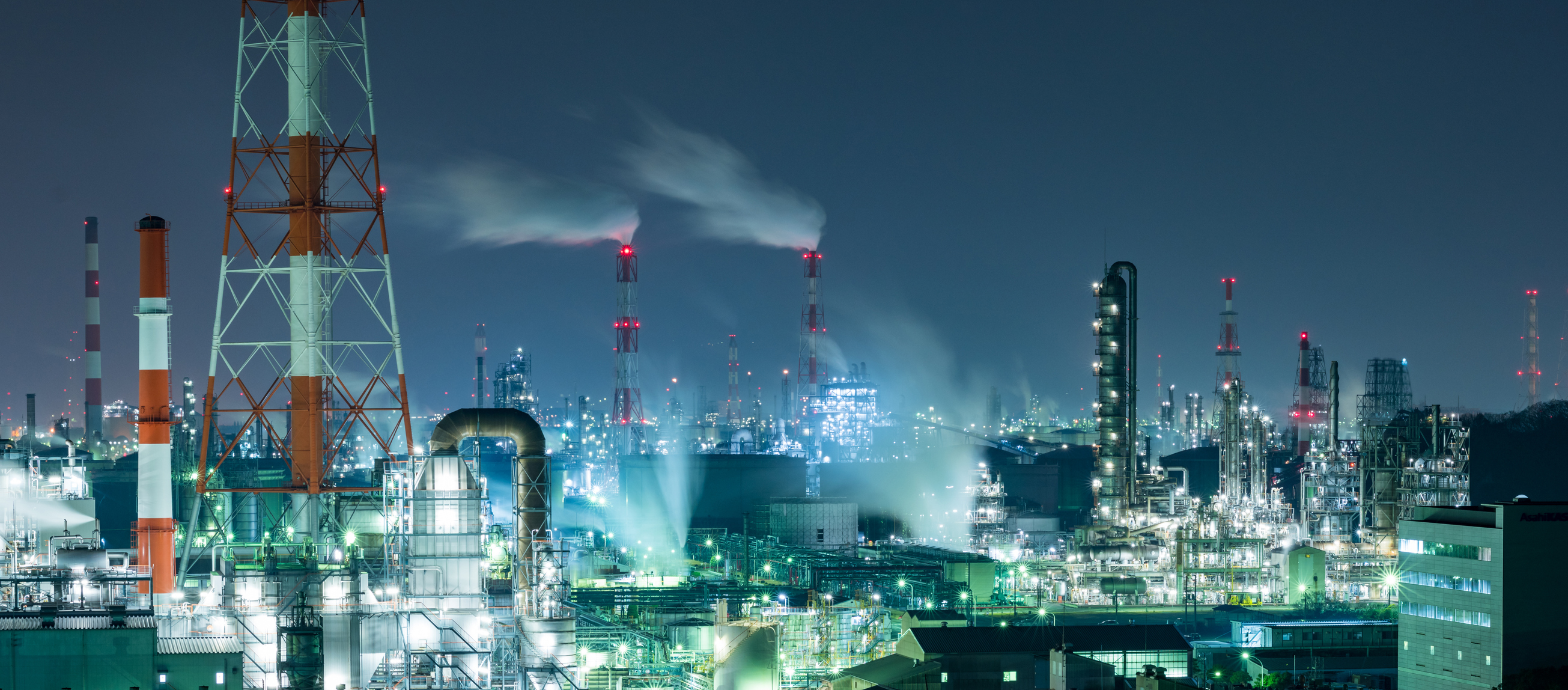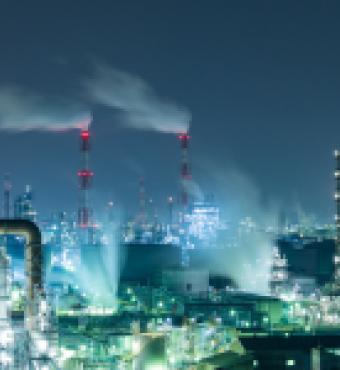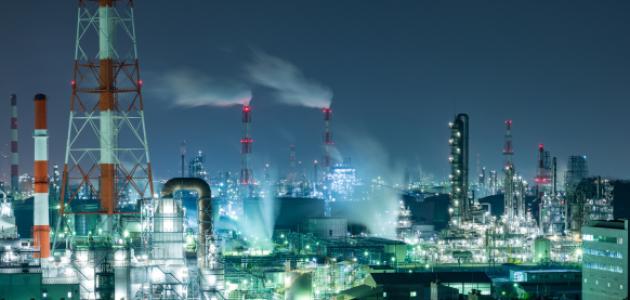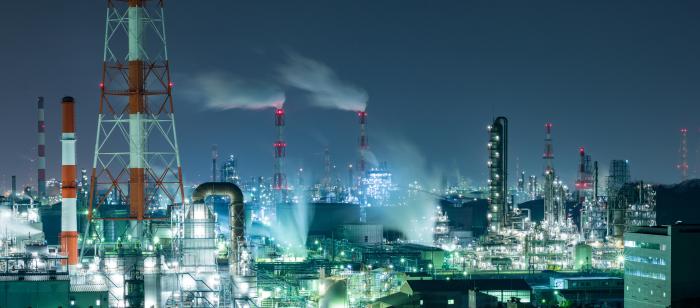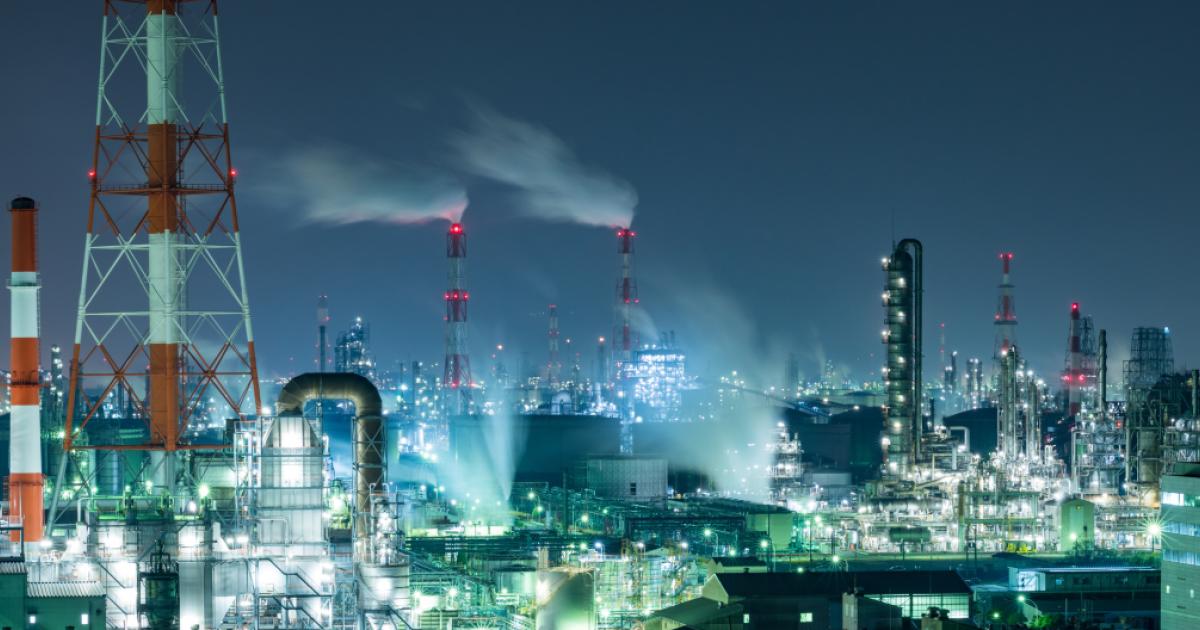- Health Care
We are intimately connected to the world around us—to the air, water, and soil that envelop us. The average adult constantly replenishes the oxygen within them by taking 12 to 20 breaths per minute; we regularly consume water, which constitutes over 50% of our body weight; we obtain most of our vital nutrients from the soil through the foods we consume. A healthy vibrant biosphere is vital for our wellbeing (see Figure 1).
Industrialization and increased human activity are changing the biosphere in ways that are detrimental to supporting life on earth. Vehicular emissions, power and heat generation, and industrial and agricultural emissions are major sources of pollutants and greenhouse gases. By increasing greenhouse gases, we are trapping heat in the atmosphere and causing global climate changes and shifts in atmospheric and ocean chemistry that affect human health and the health of the planet. Global average temperature increased by about 1.0°C from 1901 to 20161 and continues to increase. The last five years, from 2014 to 2018, are the warmest years ever recorded in the 139 years that the National Oceanic and Atmospheric Administration has tracked global heat.2
The time to act and find solutions is now. There is a ground swell of evidence that, despite certain government officials damagingly saying otherwise, should inspire and motivate us to find ways to prevent and treat the acute and chronic effects of pollution on our health.
We have seen the face of pollution in the news, wildfires raging through forests and homes, dust storms stretching far and wide, plastic patches the size of California in the ocean, floods wrecking homes and communities. But pollution also has a real human face. People around the globe have seen the human face of pollution and the real costs. The newborn baby with stunted growth born prematurely because her mother was exposed to too much air pollution in Nairobi; the elderly man dying of a heart attack after exposure to wildfire smoke 500 miles away in San Francisco; a young girl going into puberty because of chemicals from plastics in the water supply in India; a young man who cannot remember where his house is because of eating fish with mercury in Norway; a baby in London with extensively dry irritated skin because of the detergents in the washing water; a pregnant mother who drank rice milk with arsenic levels that will affect her unborn child for years to come in New Hampshire; a 56-year-old grandmother who dies due to new onset asthma in a pollen storm in Australia; and a teenager working in the fields and eating at a food stand with vegetables depleted of minerals and iron in South Carolina.
Pollution, its effects, and its consequences on health are all around us—and they reach into the future through our children. Children are particularly vulnerable to pollution. They breathe proportionally more air because of their higher respiratory rate, and they spend more time outdoors where they are exposed to airborne pollutants. The effects of pollution in children are higher as their lungs and other organs are still developing. In fact, the damage caused by air pollution can begin before a child is born. A recent study demonstrated a clear link between air pollution and stillbirths, premature births, and low birth weight infants.3 In another study, smoke from kerosene stoves was associated with reduced birth weight and micronutrient imbalance in mothers and newborns.4
The evidence that current climate change is caused by increased industrialization and human activity is now irrefutable. The detrimental effects of pollutants to human health are well documented. The scientific evidence is clear as is the need for bold and transformative policy change to promote a sustainable and healthy planet for the benefit of future generations. Scientists have identified these pollutants and their sources to understand their effects on health. Clinicians have a duty towards creating a healthier environment and protecting human health. And citizens need to work towards translating the findings from environmental research into sound policies that can create sustainable solutions for the future of our children and the health of the planet.
Pollutants and Their Effects
There are many types of pollutants. Increasing greenhouse gases are a major concern and cause thermal pollution. Others include air, water, soil, light, noise, and radioactive pollution. As human population and activity increase, there is the potential for the emission of and exposure to these pollutants to grow. If not managed, global pollution growth could have dire consequences.
Atmospheric Pollutants
Indoor and ambient (outdoor) air pollutants consist of both natural and man-made particles and gases; in high concentrations, they can have a deleterious effect both on human health and the health of the planet. Air pollution is measured by Air Quality Index (AQI) with different countries using different criteria. In the United States, AQI is based on concentrations of ground-level ozone, particulate matter (PM), carbon monoxide, sulfur dioxide, and nitrogen dioxide5; in India, AQI also includes ammonia and lead6 (see Figure 2).
Every year 4.2 million deaths occur as a result of exposure to ambient air pollution and 3.8 million die every year as a result of household exposure to smoke from dirty cookstoves and fuels.7 The World Health Organization (WHO) has identified five air pollutants of major concern: ground-level ozone, particulate matter, carbon monoxide, sulfur dioxide, and nitrogen dioxide. In the United States, the Environmental Protection Agency (EPA) included lead as the sixth major pollutant and has designated these six as “criteria air pollutants.” The Clean Air Act requires the EPA to set national ambient air quality standards for these 6 air pollutants.8,9 Besides the criteria air pollutants, a number of air pollutants that are known or suspected to cause serious health effects, such as cancer, reproductive effects, birth defects, or those that cause adverse environmental effects, have been categorized as hazardous or toxic air pollutants. Examples include gases (benzene, toluene, and xylenes), liquid aerosols (perchloroethylene and methylene chloride), and inhalable particles (polycyclic aromatic hydrocarbons, cadmium, chromium, lead, and mercury). Major gases that are emitted in significant amounts by human activity include carbon dioxide, chlorofluorocarbons (CFCs), methane, and nitrous oxide (see Figure 3).
Particulate matter pollution is a major concern and particles 10mm or below (PM10) are considered harmful to our health as they are inhaled. Those 2.5mm and smaller (PM2.5) are small enough to be inhaled deep into the lungs and enter the bloodstream, aggravating both the respiratory and cardiovascular systems.10 PM2.5 is one-thirtieth the width of a human hair (Figure 2). The chemical composition of particulate matter varies and can be made up of both man-made substances (sulfates, nitrates, ammonia, carbon, lead, organic compounds, etc.) as well as natural substances (soil, dust, bioaerosols, etc.). The mid-20th century saw large scale catastrophes. In 1948, in Donora, Pennsylvania, a deadly smog created by industrial pollutants asphyxiated 20 people and made thousands sick.11 In 1952, the Great Smog in London caused by extensive burning of high-sulfur coal killed around 12,000 people over the course of 5 days.12 Catastrophic events of that scale have been avoided by actions over the past several decades that have significantly reduced air pollution, but a number of cities still struggle with very high and extremely unhealthy levels of particulate matter. It is estimated that about 92% of the world’s population lives in areas where the air quality exceeds the limits set by WHO guidelines.13
It is now clear that both long- and short-term exposure of even moderate levels of air pollutants have detrimental health effects. A study in China found short-term exposures to PM2.5, nitrogen di oxide and ozone may increase asthma mortality risk.14 Another study in Africa found that 10 μg/m3 increase in PM2.5 concentration is associated with a 9% rise in infant mortality.15 Studies show that PM2.5 is associated significantly with increased rates of emergency department visits for asthma. In children aged 6–18 in New York City, intensive care unit admissions rates and hospitalizations increased 26% and 19%, respectively, when PM2.5 concentration increased by 12 μg/m3.16 Recent data indicate that nearly 800,000 people die prematurely each year in Europe because of dirty air and that each life is cut short by an average of more than two years.17
The seriousness of the effects of air pollution, which can be cumulative with exposure, has sometimes been downplayed. In response to heavy smog in New Delhi in November 2017, India’s Minister of Environment urged his people to remain calm, saying that the smog did not constitute a true public health emergency.18 According to the U.S. embassy’s measurements, air in Beijing reached PM2.5 concentrations of more than 300 μg/m3, and air in New Delhi reached PM2.5 concentrations of more than 1,010 μg/m3. In comparison, in the United States, due to the Clean Air Act of 1970 and its subsequent amendments in 1990, the air quality standard for the 24-hour average of PM2.5 is 35 μg/m3.19 Although there has been some recent setbacks in the current U.S. EPA scientific advisory board’s understanding of air pollution and its connection to health, on the whole, over the last 5 decades in the United States, improvements have resulted. For example, from 1970 to 2017, the annual PM2.5 has decreased by about 40%. While the United States needs to continue its progress, China and India each are starting to work on proposed solutions for their current air pollution burden, which include 1) replacing existing cook stoves with clean cook stoves, 2) reducing pollution from diesel transport, and 3) restrict open burning of biomass and fossil fuels.20
Epidemiological evidence has clearly shown associations between air pollution and mortality. Ella Kissi-Debrah, who lived near a busy street in London, was hospitalized many times for severe asthma attacks and died in 2013 when she was 9 years old. Scientists found that her hospitalizations coincided with local pollution spikes. Her mother wants to put air pollution as the cause of Ella’s death on her death certificate.22
Other air pollutants also pose serious health effects. Ozone is a pollutant that can have beneficial or harmful effects. In the stratosphere, ozone has a protective effect as it shields the earth from harmful ultraviolet radiations. However, ground-level ozone is an air pollutant that triggers wheezing, shortness of breath, and causes or aggravates other lung disease, such as chronic obstructive pulmonary disease or asthma. Ground-level ozone is formed when pollutants emitted by vehicular and industrial sources react chemically in the presence of sunlight. Exposure to ozone pollution causes increased risk of asthma, asthma exacerbations, and increased emergency room visits. Predictive models suggest that ozone-related emergency department visits for asthma in children are likely to increase by 7.3% across New York City by the 2020s.23 Nitrogen dioxide also poses documented health risks. A meta-analyses of 12 studies including nearly 100,000 children found that it significantly influences the development of childhood asthma and symptoms of wheezing.24
Combustion of coal at power plants results in air emissions of mercury, another extremely harmful air pollutant. Coal plants are responsible for 44% of U.S. mercury emissions.25 Mercury in particles in the air is a potent neurotoxin and prenatal exposures can lead to decreased motor and cognitive abilities even at low exposures.26 Mercury exposures have also been linked to higher risks of hypertension, heart disease, and stroke.27 The Mercury and Air Toxics Standards in the United States protected us to more than 80 dangerous pollutants, but now, with EPA rollbacks, they are in jeopardy. The standards prevent up to 11,000 premature deaths, 13,000 asthma attacks, and nearly 5,000 heart attacks. They deliver up to $90 billion in annual health benefits.28
Lead is another serious environmental health hazard, which can be found in air particulates. Environmental contamination occurs due to mining, smelting, manufacturing, recycling activities, and use of leaded paint, gasoline, and aviation fuel. Lead accumulates in the body and can be found in the brain, liver, kidney, and bones. There is no known level of lead exposure that is considered safe. Lead is now known to affect almost every organ/tissue of the human body. With irreversible effects on neurobiological development of young children and fetus, its toxicity has lasting implications for human life.29
Although carbon dioxide is released by living organisms, it is an air pollutant when associated with human activities involving the burning of fossil fuels. It is the most common of the greenhouse gases, which trap heat in the atmosphere and contribute to thermal pollution and climate change. Increasing carbon dioxide levels observed with climate change have been associated with increasing pollen levels.30-33 Pollen data collected in Europe indicate an increasing trend in pollen aeroallergens,32 and it is predicted that across Europe, sensitization to ragweed is likely to more than double by 2041 to 2060.31 Other greenhouse gases include methane, CFCs, nitrous oxide, and sulfur dioxide. Methane is released by landfills, the natural gas industry, and gas emitted by livestock. CFCs, are commonly used in refrigerants and aerosol propellants. Sulfur dioxide and closely related chemicals are known primarily as a cause of acid rain. Once nitrous oxide enters the upper atmosphere, it can remain there for more than 100 years before it is naturally destroyed. Over this period, one molecule of nitrous oxide has the same greenhouse warming power of 300 molecules of carbon dioxide.34
Thunderstorms during the pollen season have been linked with increased asthma exacerbations and emergency room visits.35 In 2016, several asthma deaths were observed during severe thunderstorms in Australia and Kuwait.36,37 During thunderstorms, whole pollen grains are swept into the clouds where they are broken up into smaller allergenic pollen fragments and eventually carried back to ground level.38 Similarly, dust storms and wildfires have been shown to increase asthma exacerbations.39-43 Particulate matter £10mm in dust storms are linked with asthma exacerbations.39 A 5-year study in Kuwait found that dust storm events (defined as events with PM10>200 mg/m3) were associated with respiratory disease in children.39 Rising global temperatures can lengthen the season and increase the geographic range of disease-carrying insects. Increased rainfall, flooding, and humidity can create more viable breeding areas.
Climate change fueled by greenhouse gases has already warmed the planet substantially, causing more severe and prolonged heat waves, greater variability in temperature, increased air pollution, forest fires, droughts, and floods—all of which can put the respiratory health of the public at risk.44 A 2007 WHO report expected that by 2025 the prevalence of asthma will increase by 25% to about 400 million.45 Wildfire smoke contains carbon dioxide, water vapor, carbon monoxide, particulate matter, complex hydrocarbons, nitrogen oxides, trace minerals, and several other toxic and carcinogenic compounds. California witnessed devasting fires in the last 2 years. In 2017–2018, extreme wildfires occurred in Southern and Northern California, both located at wildland-urban interfaces. Damaging smoke from wildfires have been detected as far as 1,000 miles away. In a study investigating health effects of a 2008 California wildfire, risk of asthma exacerbation as determined by a 4-fold increase in emergency department visits was found to be associated with wildfire PM2.5.43
In addition to outdoor air pollution, indoor air pollution is also of concern. Sources of indoor air pollution include fuels (oil, gas, coal, wood), molds, tobacco products, building materials, household cleaning products, and heating and cooling systems. Around 3 billion people still cook using wood, crop wastes, charcoal, coal, dung, or kerosene as fuels, which produces high levels of particulate matter. In poorly ventilated dwellings, indoor smoke can be 100 times higher than acceptable levels for fine particles. Exposure is particularly high among women and young children, who spend the most time near the domestic hearth.46 Access to clean fuels and technologies for cooking is important to lower indoor pollution. Some outdoor substances can enter the home or building and increase indoor pollutant levels. Radon is a colorless, odorless radioactive gas found in soils. It enters through the ground and into the home through openings in the floors and walls. It decays, giving off radioactive particles. Long-term exposure to these particles can lead to lung cancer.47 Radon detection devices are commercially available and are relatively simple. Sealing cracks and diverting radon away with vacuum or ventilation systems is the best way to prevent radon exposure.48
Solutions: The scientific consensus is overwhelming and leaves little room for dispute—increased human activity and emission of pollutants and greenhouse gases are harming human health and the health of the planet. Climate change is real and clearly points to the need for bold and transformative policy change and clear action items to mitigate or reverse these trends. The 2015 Paris Climate Accord represents the world’s desire to combat climate change through reduction of greenhouse gas emissions. The central aim of this international cooperation is to strengthen the global response to the threat of climate change with a goal of limiting global temperature rise this century to 2°C above pre-industrial levels and to pursue efforts to limit the temperature increase even further to below 1.5°C.49 Meanwhile, the first WHO Global Conference on Air Pollution and Health was held in Geneva in November 2018.50 There was participation from and collaboration with national and city governments, intergovernmental organizations, civil society, philanthropy, research, and academia. Participants at the conferences highlighted a goal of reducing the number of deaths from air pollution by two thirds by 2030. To reach these goals, one of the important items put forward was to continue the joint effort for harmonized air pollution monitoring through initiatives such as the Global Platform on Air Pollution and Health. This initiative aims to strengthen air quality monitoring and the assessment and reporting of related health impacts across nearly 50 such agencies around the world. Another item was to increase efforts to scale up the “BreatheLife” campaign51 by enlisting 500 BreatheLife cities and 20 countries by 2020, all committing to reaching WHO air quality guideline levels by 2030. One such member is Oslo, Norway, which has focused on promoting the use of zero-emission vehicles in the urban areas through decreased taxes, access to bus and taxi lanes, free tolls on roads and ferries, and free municipal parking.52 A 2018 Greenpeace report indicated that Oslo was the only city in their analysis that has emissions below both the European Union limit and the World Health Organization guidelines.53 So it is possible and some cities are leading by example to change the future.
Water Pollution
Water pollution is one of the major crises in public health today, and it affects millions of people who do not have access to clean drinking water. Water pollution is caused by rapidly growing urban developments and improper disposal of household and other chemicals by residents, improper sewage disposal, dumping of chemical wastes by industry and agriculture, silt runoff from construction, discharge of radioactive wastes, detergents, microplastics, medical drugs, and oil spills. These pose health risks for humans, plants, and animals now and in the future. Two major recent oil spill disasters include the Exxon Valdez oil spill in Prince William Sound, Alaska, in 1989 and the BP Deepwater Horizon explosion in the Gulf of Mexico in 2010. The total volume of oil from the Exxon Valdez spill covered more than 1,300 miles of shoreline. Exxon Valdez was a single-hulled ship. Single-hulled tankers are now barred from using U.S. ports and as of 2015 have been phased out throughout much of the world under International Maritime Organization agreements.54 In the Deepwater Horizon disaster, over 200 million gallons of crude oil spilt from a wellhead at 5000 feet in the deep ocean. The oil flowed over an 87-day period, before it was finally capped.55 Some of the immediate changes the Bureau of Safety and Environmental Enforcement and the Bureau of Ocean Energy Management implemented after the Deepwater Horizon oil spill were increasing well-design standards, oversight by third parties, and monitoring. However, the Trump administration is planning to reverse these rules, which were enacted to ensure that similar accidents are prevented in the future.56 In addition to spills in the ocean, major contaminations have occurred in water supplies. In 2014, China’s biggest oil company was blamed for contaminated water affecting over 2.4 million people in Lanzhou. Benzene, a known carcinogen, was found at 20 times the national safety limit. In 2014, Flint, Michigan, authorities switched its drinking water supply from Detroit’s system to the Flint River in a cost-saving move. Corrosive water caused lead from old pipes to leach into the water system and into people’s homes. The contaminated water led to a doubling or tripling of the incidence of elevated blood lead levels in children. After international publicity and court actions, the city switched to a new supplier for water and is replacing lead pipes.57
Under the right conditions, such as warmer water temperatures or excessive nutrients from fertilizers or sewage waste runoff, algae can grow out of control and some can produce toxins that can affect humans and wildlife. Even excessive growth of nontoxic algae can decrease oxygen levels in the water and may smother fish and other vegetation. With climate change, scientists expect these so-called «harmful algal blooms» to become more frequent, wide-ranging, and severe.58 In the Bering Straits, decreases in the thickness of the ice and increased penetration of light has led to toxic algal blooms. Some algal poisons kill fish and may cause brain damage in people. Cases of paralytic shellfish poisoning have increased seven-fold in Alaska over the past 40 years. The state now has one of the highest incidences of shellfish poisoning in the world.59
In 2014, harmful algal blooms contaminated drinking water in Toledo, Ohio, with microcystin, a toxin that can cause liver and kidney damage, causing the water system to be shut down for three days. Fertilizer runoff and septic systems from developments alongside Lake Erie have led to a series of annual algal blooms in the area, and local residents are now attempting to save the failing health of the world’s 11th largest lake through legal action.60
Coral reefs are an important part of the ecosystem and are responsible for providing shelter and food to around a quarter of all ocean species.61 Coral reef ecosystems are among the most biologically diverse and complex marine ecosystems worldwide. While covering less than 1% of the ocean surface, coral reefs provide a habitat for nearly one third of marine fish species as well as 10% of all fish captured for human consumption. Unfortunately, the World Conservation Institute estimates that 20% of coral reefs are already destroyed, another 25% are at immediate threat, and another 25% will be threatened by 2050. Regenerating ocean life and establishing marine protected areas are vital. At the current time, only 4.8% of the world’s oceans are actively managed marine protected areas, and conservation organizations have proposed significantly increasing this share.62 Other efforts include repopulating coral reefs with reef fish and crustaceans and by coral gardening. Decreasing pollutants is also key in efforts to improve the health of the oceans. In February 2019, Key West voted to ban the sale of certain sunscreens containing chemicals, which are believed to harm coral reefs.63 The compounds in most sunscreens catalyze the production of hydrogen peroxide, a well-known bleaching agent, at a concentration high enough to harm coastal marine organisms.
Pollution of our waters by plastics is ubiquitous, with an estimated 18 billion pounds of plastic waste entering the world’s oceans each year.64 Great Britain’s Royal Statistical Society has estimated that 90.5% of plastic ever made has never been recycled.65 Trash accumulates in five ocean garbage patches, the largest one being the Great Pacific Garbage Patch, located between Hawaii and California. Many animals ingest plastics and often die of complications or starvation. In 2017, for example, a large sperm whale was found beached with 64 pounds of trash in its digestive track.66 Plastics degrade on exposure to sun, wind, and rain and form smaller and smaller particles, termed microparticles. It is now evident that microplastics have permeated remote areas of the planet, including our oceans. A recent study has now found microplastics in the stools of humans and their effects on human health and wellbeing are unknown.67 Microbeads, plastic beads smaller than 5mm or less, are another source of microplastics. They were being used in a number of cosmetics to exfoliate skin. To address concerns of microbeads in the water supply, the U.S. Congress passed the Microbead-Free Waters Act of 2015, which prohibits the manufacturing, packaging, and distribution of rinse-off cosmetics containing plastic microbeads.68
Marian Chertow, an associate professor at the Yale School of Forestry & Environmental Studies and director of the program on solid waste policy, noted that in 2008 China passed a law promoting a circular economy. The idea is you make a product with material you know can be recycled rather than make a product and then figure out how to recycle it. In 2017, China banned import of plastic waste. As China was importing about 45% of the world’s plastics, countries like the United States now have an economical and environmental imperative to lower use of plastics and recycle them locally.69,70. With increasing recognition of the magnitude of the problem, there are considerable efforts to push for legislation to limit the use of plastics (especially single use plastics). In 2018, the European Parliament approved a ban on single-use plastics such as straws and plates in Europe by 2021.71 Similar bans are in effect or under consideration in many cities and countries.
Soil, Radioactive, Light, and Noise Pollution
Nuclear power plants offer a means of producing energy without the production of carbon-dioxide emissions. Spent fuel from nuclear power plants and other civil and military nuclear waste need to be protected from the environment for a considerable period of time, since some radioactive components decay over very long periods of time. Radioactive wastes are generally placed in interim storage facilities pending further technical and political consideration of long-term solutions.
Soil pollution perhaps gets less attention than that of water or air; as years can go by before the true effect of the damage can be realized. According to the 2018 Food and Agriculture Organization (FAO) report, the total number of contaminated sites is estimated at 80,000 across Australia; 3 million in the European Economic Area and cooperating countries in the West Balkans; and 1,300 in the United States. In China, the Chinese Environmental Protection Ministry, estimated that 16% of all Chinese soils and 19% of its agricultural soils are categorized as polluted.72 Official estimates say that China produces 12 million tonnes of heavy-metal contaminated grain a year.73 In 2018, China passed its first law on soil pollution prevention and control and is in the process of setting national standards for soil pollution risk control based on the soil’s contamination status, public health risks, and ecological risks.74
Based on evidence on the adverse health effects of environmental noise on cardiovascular and metabolic effects, sleep quality, cognitive function, hearing, birth outcomes, quality of life, mental health, and wellbeing, in 2018, the WHO developed guideline recommendations for protecting human health from exposure to environmental noise originating from various sources such as transportation or wind turbines.75 Noise pollution also affects animal life. Even the oceans are getting louder as a result of increased global shipping and geologic exploration activities. Such noise can disrupt marine life, including migration and lifecycle patterns. A 2017 study found that loud, underwater noises such as those used in marine seismic survey operations, could kill a majority of zooplankton within a three-quarter mile radius.76 Although limiting the number and intensity of seismic blasts would be in the best interest for marine life in the oceans, the United States is currently pursuing plans increase seismic surveys along the Atlantic coast for energy production.
Light pollution also has effects on humans and other animals. The light of the moon is an important focal point for many organisms. Coral spawn during the full moon in October and November; baby turtles are drawn to the water by the moon’s reflection on the ocean waves. Artificial illumination has been shown to mask the moon’s phases potentially causing the reefs to release their reproductive cells out of sync, thwarting their chances of producing offspring. Turtles can be directed to artificial light in the direction away from the ocean.77 In humans, light pollution can disturb a person’s circadian rhythm.
Solutions for Global Pollution and Climate Change
Our progress in mitigating climate change has been followed by setbacks. The United States withdrew from the Paris accord in 2018, and now the EPA Scientific Advisory Board in March 2019, with members recognizably conflicted due to their industry ties, has questioned air pollution’s effect on health. However, we have historical precedent for how countries, including the United States, have worked together on global environmental issues, yielding significant results. For instance, following the phase out of CFCs through the 1987 Montreal Protocol, the seasonal hole in the Antarctic ozone layer has in recent years started to diminish. This highlights the impact of motivated citizens to speak up, persist, and apply political pressure at the global, national, and local level.
We should be equally concerned about the effects of climate change on human health and are implementing plans to step up and catalyze innovative approaches to address health (both public and individual) associated with increasing levels of pollution. Doing so will require making the social, health, and economic case for taking action now to address the large and growing global burden. Notably, when countries have passed laws to decrease pollution exposure on their citizens, the increases in worker productivity and economic profits have been dramatic.78
Importantly, while progress on preventing, mitigating, and managing pollution will need to occur at a global level, we need to see change in companies, hospitals, and public health systems. Movements are occurring to build ‘green’ industry campuses, build lower energy-using hospital and clinic buildings, and reduce waste from hospitals. University campuses are improving their energy use and recycling processes. Individuals can also help. Online tools, for example, can educate and assist in calculating one’s carbon footprint and social media can help motivated individuals find and share ways to reduce their carbon footprints,79 whether through reducing one’s dependence on fossil fuels and plastics, reducing family-level consumption, recycling and energy efficiency, promoting sustainable healthy living, or supporting responsible public policies across different levels of government.
Dr. Kari Nadeau is the director of the Sean N. Parker Center for Allergy and Asthma Research at Stanford University and the section chief of Allergy and Asthma and Naddisy Foundation professor of Pediatric Food Allergy, Immunology, and Asthma at the Stanford University School of Medicine.
Supporting Data
Figure 1. Pollution Can Modify Our Body at All Levels

Source: Mikael Häggström, “Medical gallery of Mikael Häggström 2014”. WikiJournal of Medicine 1 (2). Public Domain. Available at https://en.wikipedia.org/wiki/Pollution#/media/File:Health_effects_of_pollution.png
Figure 2. Size of Particulate Matter

Source: “Particulate Matter (PM) Basics,” U.S. Environmental Protection Agency, available at https://www.epa.gov/pm-pollution/particulate-matter-pm-basics
Figure 3. Air Quality Indices
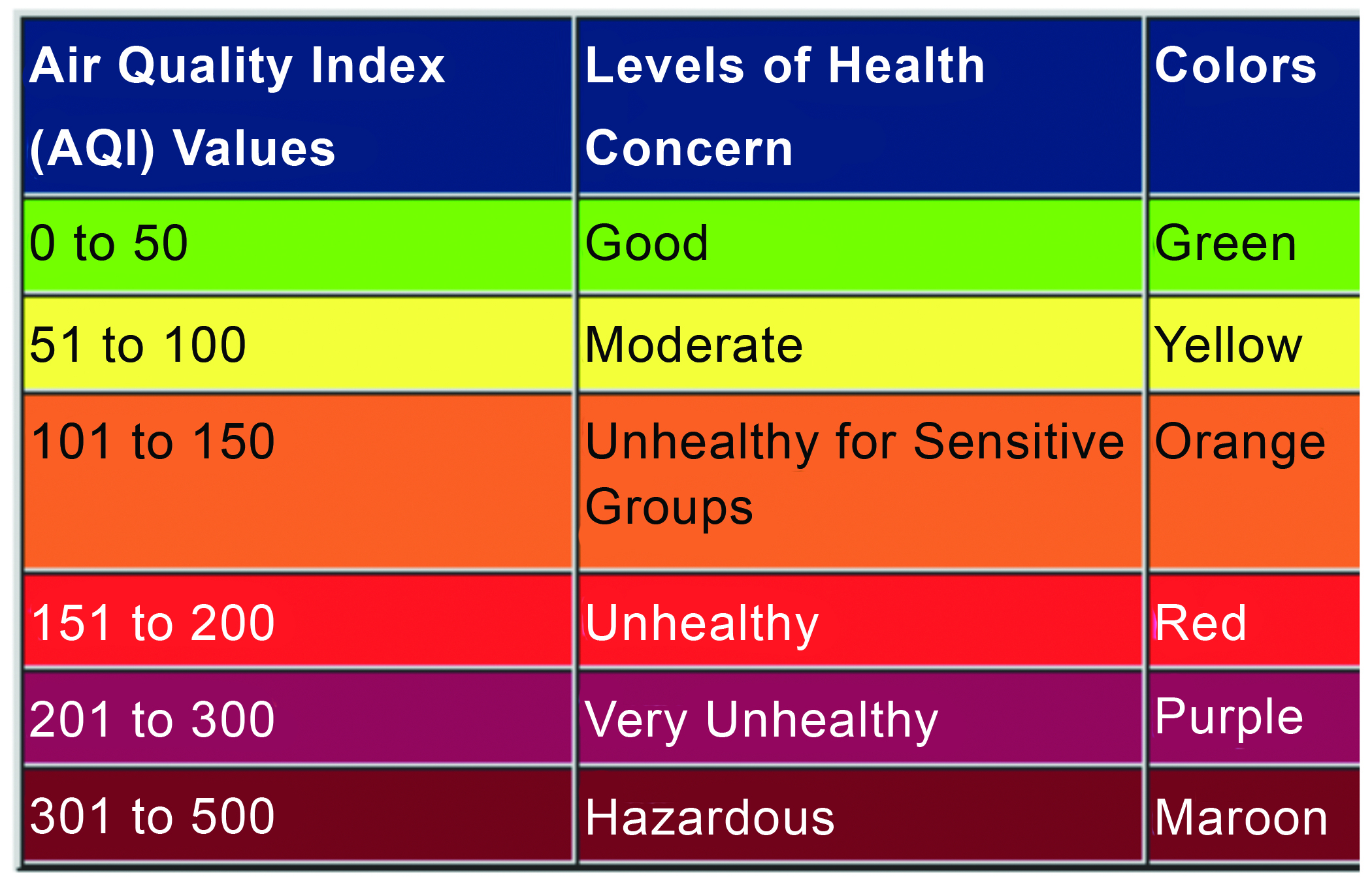
Source: “Air Quality Index (AQI) Basics,” U.S. Environmental Protection Agency, available at https://airnow.gov/index.cfm?action=aqibasics.aqi







